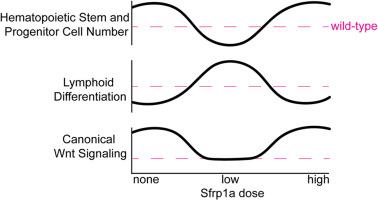Secreted frizzled-related protein 1a regulates hematopoietic development in a dose-dependent manner
IF 2.1
3区 生物学
Q2 DEVELOPMENTAL BIOLOGY
引用次数: 0
Abstract
Hematopoietic stem and progenitor cells (HSPCs) are only generated during embryonic development, and their identity specification, emergence from the floor of the dorsal aorta, and proliferation are all tightly regulated by molecular mechanisms such as signaling cues. Among these, Wnt signaling is crucial for HSPC specification, differentiation, and self-renewal, requiring precise regulation for proper development and homeostasis. Wnt signaling begins when a Wnt ligand binds to cell surface receptors, such as those encoded by the frizzled gene family, activating intracellular pathways that regulate gene expression. Secreted frizzled-related proteins (Sfrps) are known to modulate Wnt signaling, acting as both agonists and antagonists. However, the in vivo roles of Sfrps in HSPC development are not fully understood. Here, we show that Sfrp1a influences zebrafish HSPC development and hematopoietic differentiation in a dose-dependent manner. Sfrp1a loss-of-function animals display an upregulation of canonical Wnt signaling, increased HSPC proliferation, and reduced differentiation into lymphoid and myeloid lineages. Conversely, low-dose overexpression of sfrp1a leads to decreased HSPC numbers and enhanced lymphoid differentiation. High-dose sfrp1a overexpression mimics the loss-of-function phenotype, with elevated canonical Wnt signaling, increased HSPCs, and decreased lymphoid and myeloid differentiation. These results emphasize the importance of dose-dependent Sfrp regulation, paralleling observations in hematopoietic cancers where SFRP1 variants can either promote or inhibit tumor development.

分泌卷曲相关蛋白1a以剂量依赖的方式调节造血发育。
造血干细胞和祖细胞(HSPCs)仅在胚胎发育过程中产生,其身份规范、从背主动脉底出现和增殖都受到信号信号等分子机制的严格调控。其中,Wnt信号对HSPC规范、分化和自我更新至关重要,需要精确的调控才能正常发育和体内平衡。Wnt信号传导始于Wnt配体与细胞表面受体(如卷曲基因家族编码的受体)结合,激活调节基因表达的细胞内通路。已知分泌卷曲相关蛋白(strps)调节Wnt信号,作为激动剂和拮抗剂。然而,条带蛋白在HSPC发展中的体内作用尚不完全清楚。在这里,我们发现strp1a以剂量依赖的方式影响斑马鱼HSPC的发育和造血分化。Sfrp1a功能缺失的动物表现出典型Wnt信号上调,HSPC增殖增加,向淋巴和髓系分化减少。相反,低剂量过表达sfrp1a会导致HSPC数量减少和淋巴细胞分化增强。高剂量的sfrp1a过表达模拟功能丧失表型,典型Wnt信号升高,HSPCs增加,淋巴细胞和髓细胞分化减少。这些结果强调了剂量依赖性Sfrp调控的重要性,在造血癌症中,SFRP1变异可以促进或抑制肿瘤的发展。
本文章由计算机程序翻译,如有差异,请以英文原文为准。
求助全文
约1分钟内获得全文
求助全文
来源期刊

Developmental biology
生物-发育生物学
CiteScore
5.30
自引率
3.70%
发文量
182
审稿时长
1.5 months
期刊介绍:
Developmental Biology (DB) publishes original research on mechanisms of development, differentiation, and growth in animals and plants at the molecular, cellular, genetic and evolutionary levels. Areas of particular emphasis include transcriptional control mechanisms, embryonic patterning, cell-cell interactions, growth factors and signal transduction, and regulatory hierarchies in developing plants and animals.
 求助内容:
求助内容: 应助结果提醒方式:
应助结果提醒方式:


